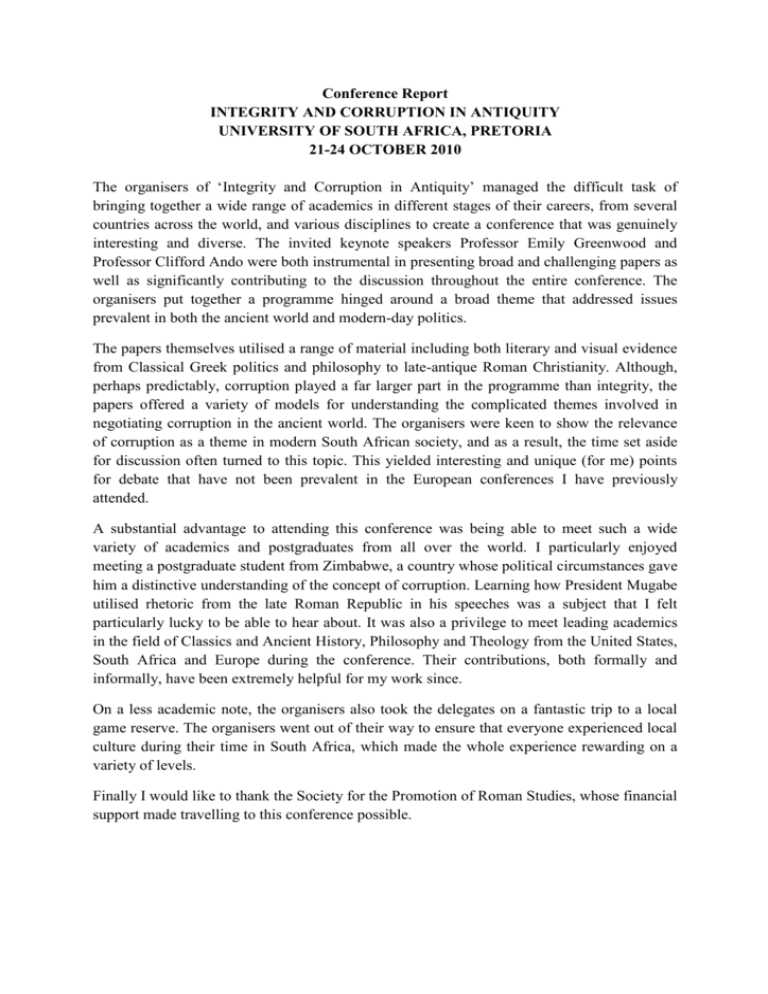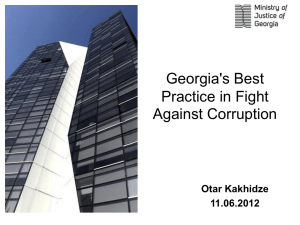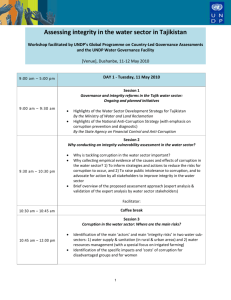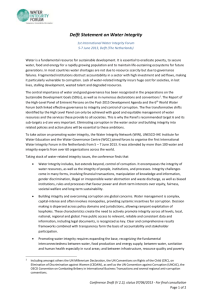S Malik - Society for the Promotion of Roman Studies
advertisement

Conference Report INTEGRITY AND CORRUPTION IN ANTIQUITY UNIVERSITY OF SOUTH AFRICA, PRETORIA 21-24 OCTOBER 2010 The organisers of ‘Integrity and Corruption in Antiquity’ managed the difficult task of bringing together a wide range of academics in different stages of their careers, from several countries across the world, and various disciplines to create a conference that was genuinely interesting and diverse. The invited keynote speakers Professor Emily Greenwood and Professor Clifford Ando were both instrumental in presenting broad and challenging papers as well as significantly contributing to the discussion throughout the entire conference. The organisers put together a programme hinged around a broad theme that addressed issues prevalent in both the ancient world and modern-day politics. The papers themselves utilised a range of material including both literary and visual evidence from Classical Greek politics and philosophy to late-antique Roman Christianity. Although, perhaps predictably, corruption played a far larger part in the programme than integrity, the papers offered a variety of models for understanding the complicated themes involved in negotiating corruption in the ancient world. The organisers were keen to show the relevance of corruption as a theme in modern South African society, and as a result, the time set aside for discussion often turned to this topic. This yielded interesting and unique (for me) points for debate that have not been prevalent in the European conferences I have previously attended. A substantial advantage to attending this conference was being able to meet such a wide variety of academics and postgraduates from all over the world. I particularly enjoyed meeting a postgraduate student from Zimbabwe, a country whose political circumstances gave him a distinctive understanding of the concept of corruption. Learning how President Mugabe utilised rhetoric from the late Roman Republic in his speeches was a subject that I felt particularly lucky to be able to hear about. It was also a privilege to meet leading academics in the field of Classics and Ancient History, Philosophy and Theology from the United States, South Africa and Europe during the conference. Their contributions, both formally and informally, have been extremely helpful for my work since. On a less academic note, the organisers also took the delegates on a fantastic trip to a local game reserve. The organisers went out of their way to ensure that everyone experienced local culture during their time in South Africa, which made the whole experience rewarding on a variety of levels. Finally I would like to thank the Society for the Promotion of Roman Studies, whose financial support made travelling to this conference possible. Abstract ULTIMATE CORRUPTION MANIFEST: NERO AS THE ANTICHRIST IN LATE ANTIQUITY In this paper I will discuss the manifestation of ultimate corruption: the apocalypse as designed by Satan and orchestrated by the Antichrist. The Antichrist is the symbol of corruption in the extreme; it was widely acknowledged by late antique writers including Lactantius, Sulpicius Severus and Jerome that the First Beast in the Book of Revelation was considered to represent the emperor Nero. Key to this interpretation was Nero as the archetypal persecutor of the Christians, and included amongst his victims were the Apostle Peter and Saint Paul. Although this is undoubtedly highly significant, these writers were also heavily influenced by the traditions of earlier Roman historiography, which had long pictured Nero as the worst of emperors; a status justified by parading a long list of Nero’s corruption of moral, sexual, social, political, religious, and ethnic norms in Rome. In the works of a fledgling Christian religion all of Nero’s many earthly vices, recorded by the likes of Tacitus to reflect the corruption at the heart of imperial power, came to be understood to have grave eschatological repercussions and I will argue that it is through this process that Nero came to symbolise ultimate corruption; the manifest destructor of the world. Miss Shushma Malik PhD candidate Classics and Ancient History University of Bristol







